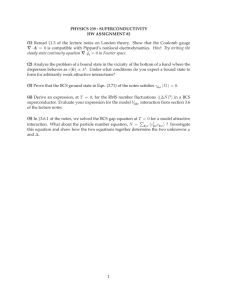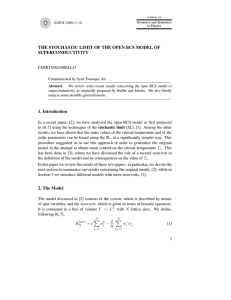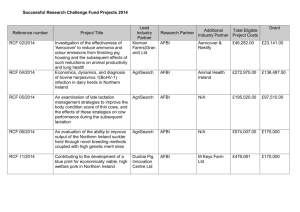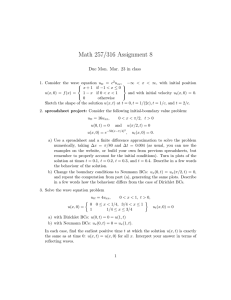Weather, climate, and water: an assessment of risk, vulnerability, and... the U.S.-Mexico Border
advertisement
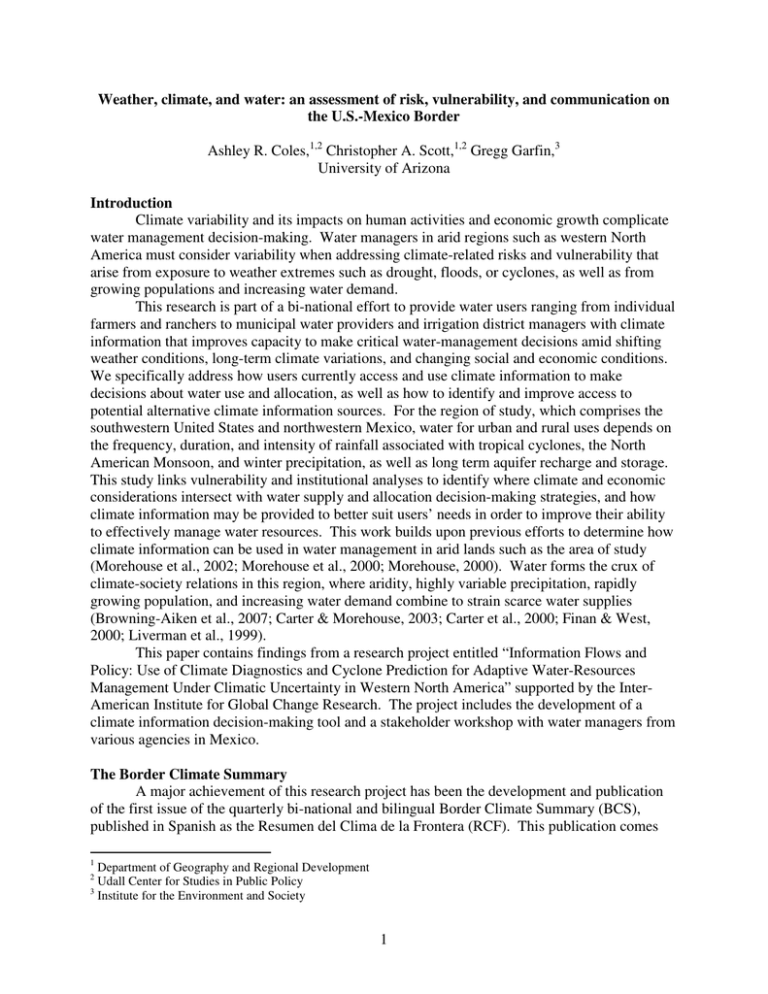
Weather, climate, and water: an assessment of risk, vulnerability, and communication on the U.S.-Mexico Border Ashley R. Coles,1,2 Christopher A. Scott,1,2 Gregg Garfin,3 University of Arizona Introduction Climate variability and its impacts on human activities and economic growth complicate water management decision-making. Water managers in arid regions such as western North America must consider variability when addressing climate-related risks and vulnerability that arise from exposure to weather extremes such as drought, floods, or cyclones, as well as from growing populations and increasing water demand. This research is part of a bi-national effort to provide water users ranging from individual farmers and ranchers to municipal water providers and irrigation district managers with climate information that improves capacity to make critical water-management decisions amid shifting weather conditions, long-term climate variations, and changing social and economic conditions. We specifically address how users currently access and use climate information to make decisions about water use and allocation, as well as how to identify and improve access to potential alternative climate information sources. For the region of study, which comprises the southwestern United States and northwestern Mexico, water for urban and rural uses depends on the frequency, duration, and intensity of rainfall associated with tropical cyclones, the North American Monsoon, and winter precipitation, as well as long term aquifer recharge and storage. This study links vulnerability and institutional analyses to identify where climate and economic considerations intersect with water supply and allocation decision-making strategies, and how climate information may be provided to better suit users’ needs in order to improve their ability to effectively manage water resources. This work builds upon previous efforts to determine how climate information can be used in water management in arid lands such as the area of study (Morehouse et al., 2002; Morehouse et al., 2000; Morehouse, 2000). Water forms the crux of climate-society relations in this region, where aridity, highly variable precipitation, rapidly growing population, and increasing water demand combine to strain scarce water supplies (Browning-Aiken et al., 2007; Carter & Morehouse, 2003; Carter et al., 2000; Finan & West, 2000; Liverman et al., 1999). This paper contains findings from a research project entitled “Information Flows and Policy: Use of Climate Diagnostics and Cyclone Prediction for Adaptive Water-Resources Management Under Climatic Uncertainty in Western North America” supported by the InterAmerican Institute for Global Change Research. The project includes the development of a climate information decision-making tool and a stakeholder workshop with water managers from various agencies in Mexico. The Border Climate Summary A major achievement of this research project has been the development and publication of the first issue of the quarterly bi-national and bilingual Border Climate Summary (BCS), published in Spanish as the Resumen del Clima de la Frontera (RCF). This publication comes 1 Department of Geography and Regional Development Udall Center for Studies in Public Policy 3 Institute for the Environment and Society 2 1 out of a recommendation from the Monsoon Region Climate Applications bi-national workshop that was held in May of 2006 (Garfin et al., 2006; Ray et al., 2007b). The BCS/RCF compiles recent climate conditions as well as seasonal climate forecasts for the Mexico-United States border region, including precipitation, temperature, drought, and El Niño conditions. Data are produced by agencies such as NOAA’s Climate Prediction Center, the International Research Institute for Climate and Society at Columbia University, and Servicio Meteorológico Nacional, which is the Mexican equivalent of the U.S. National Weather Service (NWS); climate outlook information are then interpreted and synthesized in the BCS/RCF. The publication also contains articles that cover weather- and climate-related topics contributed by researchers and practitioners from a variety of institutions and agencies. The intent is to improve the quality and reach of climate and water information disseminated to assist decision making and to improve climate science literacy among users of this information. The BCS/RCF is modeled after efforts in the United States from two NOAA Regional Integrated Sciences and Assessments programs: the Climate Assessment for the Southwest (CLIMAS, Liverman and Merideth, 2002; Bales et al., 2004), which has produced the Southwest Climate Outlook since 2002 (Garfin and Morehouse, 2003; Jacobs et al. 2005), and the Western Water Assessment, which has produced the Intermountain West Climate Summary since 2004. Both of these products have been tested among users in various sectors to determine the optimal combination, presentation, and resolution of data (Garfin et al., 2006). The Spanish-language RCF was formally tested at a meeting of regional stakeholders involving municipal and rural water managers to see if the information provided was clear, understandable, and useful for decision-making. The results of the assessment and the steps that the research team have taken to address that feedback are provided in the next section. Future iterations of this type of interaction will shape the BCS/RCF into a product that meets the needs of a spectrum of climate information users in the border region. The BCS/RCF is currently distributed via two e-mail listservs to over 1,600 individuals in the U.S. and Mexico, and is available on the websites of CLIMAS4 and the Centro de Investigación Científica y de Educación Superior de Ensenada.5 Future plans include efforts to provide the BCS/RCF to a broader public, including those without internet access. Water Manager Workshop To engage with urban and rural water managers in Mexico, the research team hosted a workshop in November, 2008 in Hermosillo, Sonora. Participants included representatives from universities, local, state, and national agencies for water management, agriculture, development, environmental protection, and natural hazards. The research team probed the current state of vulnerability and flows of weather and climate information through small and full group discussions. The workshop also facilitated the development of connections among the research team and water managers that will enable future exchanges and collaborations. Additionally, participants provided feedback on the RCF in a survey questionnaire and subsequent discussions. Small and Full Group Discussions Participants were divided into four breakout groups for discussions on a) cold fronts and freezes, b) the North American Monsoon and hurricanes, c) drought, and d) water resources. Each group was responsible for identifying sources of vulnerability associated with their topic, 4 5 http://climas.arizona.edu/forecasts.html http://gaceta.cicese.mx/ver.php?topico=breviario&ejemplar=128&id=1691 2 currently used and potential adaptive strategies, the agencies involved in risk mitigation, and the types of information useful or necessary for decision making, including which types of information are currently or might be provided in the BCS/RCF. Table 1 is a summary of the results of the group discussions. The groups identified several weather-related phenomena that pose risk for society and the economy, including short-term severe weather conditions such as intense rains or high winds, and long-term climate conditions such as prolonged drought. They also identified sociallyinduced sources of vulnerability, including the lack of construction regulations to prevent development in hazardous areas. Several of the managers also indicated that bureaucratic structures prevent them from acting outside of their prescribed duties, even if they have identified a risk that they could potentially reduce. To reduce risks, participants suggested infrastructure improvements, legislation, enhancing risk manager knowledge and resources, and public education. Infrastructure improvements were recommended for augmenting water supplies and include more efficient water delivery systems and facilities to treat, desalinate, or recharge water into aquifers. The participants targeted agricultural water use as a major source of vulnerability to water scarcity in other sectors, and therefore recommended legislation such as the removal of subsidies and raising the costs of electricity and water. However, some recommended support for agricultural production in the form of increased access to insurance in order to reduce risk from weather- or climate-related damages. Many of the participants indicated a need for more research to improve their own understanding of both physically- and socially-derived vulnerability. Proposed research includes hydrologic response to climate and land cover change, relationships between lower and upper basin water users, and vulnerability map improvement. Some participants expressed an interest in bi-national collaboration and inquired about potential funding opportunities for such work. Data have already exchanged hands across the border since the meeting occurred, and the newly established connections will facilitate future collaboration. Another recommendation for risk reduction was public education and information. Timely information that includes specific procedures for confronting hazards could reduce vulnerability among the general public. However, the participants noted that they must first try to promote a “culture of information use” in an area where few use weather or climate information to make decisions. Similarly, state and national water managers hope to strengthen a previously-started program to establish a “culture of water” by educating the public about the need for water conservation and steps they may take to reduce water usage. “Accountability” was stressed through creating and enforcing regulations. Workshop participants and the research team alike expect that the BCS/RCF will provide a vehicle for providing the general public with information about weather- and climate-related impacts and how to mitigate risks. The workshop participants identified several public sector agencies that are responsible for risk mitigation. State and federal government agencies, emergency response, disaster relief, and insurance companies were frequently mentioned. Each of the breakout groups agreed that weather and climate information would assist decision-makers in these agencies. The information needs listed included advanced warning for identified risks, technical and scientific data to aid decision-making, historical data, and specialized impact information for various sectors and regions. Many of the participants believed that the BCS/RCF would be an appropriate venue for transmission of such information among the public, agencies, and researchers. In order to improve the value of the BCS/RCF for a broad range of potential users, 3 the workshop participants provided further feedback via a survey questionnaire that was distributed at the meeting. The results of that survey are summarized in the following section, along with steps being taken by the research team to address the comments and to modify the BCS/RCF into an optimal decision-making tool. Review of the Border Climate Summary A survey questionnaire was distributed along with copies of the October 2008 issue of the BCS/RCF in order to obtain feedback for future issues. The questions for the survey were derived from previous surveys and workshops used to develop the Southwest Climate Outlook and the Intermountain West Climate Outlook, which served as the models for the BCS/RCF. The sample size of 34 completed questionnaires precludes robust statistical analysis, but the feedback provided will form the basis for future interactions with broader stakeholder groups as the product is increasingly made available. The questionnaires included both categorical and free-response questions regarding content, clarity, and presentation of data. The survey asked what sources of information the water managers currently use for climate data, and listed some options produced in both Mexico and the U.S. Figure 1 shows the percentage of respondents that use each source. The majority of the managers (88 percent) consult climate products from SMN, While 80 percent already consult at least one source from the U.S., such as the NWS or the Climate Prediction Center, 88 percent said that they would like to see more information about conditions north of the border. Of particular interest are climate impacts, surface and groundwater flows – information on which is currently difficult to access in Mexico (Scott & Bannister, 2008). The interest in U.S. data is noteworthy given that only a single individual marked the U.S. as an area of concern to their organization. Along with sources of information, the questionnaire asked what types of information the managers would find useful. In addition to temperature and precipitation, respondents would like to see recent conditions and predictions for humidity, winds, tropical storms, severe weather, ocean conditions, solar radiation, and ground and surface water resources. In most cases, these types of information can be included as feature articles that are provided in a timely manner. For example, the April 2009 publication could include outlooks for the North American Monsoon and tropical storm seasons that will occur over the summer and early fall. Given the potential for severe weather, it is not surprising that nearly half (47 percent) of the participants listed summer as the season in which they are most concerned about weather and climate (see Figure 2). The participants also listed a number of other topics that they would like to see covered in the articles, including impacts of climate and land cover change on particular sectors, historical data, and adaptive strategies being employed by other agencies. The inclusion of these topics depends on the availability of authors for relevant articles, but the extensive network of researchers and practitioners available to the research team ensures the possibility of a wide variety of articles for future publications. One of the problems of the RCF mentioned on most of the surveys was that of scale, in both temporal and spatial dimensions. Some indicated that a seasonal time frame was too long for their decision-making criteria, and that they would need data on monthly, weekly, or even a daily basis. Instead of expanding the BCS/RCF to cover these, however, alternative sources of information will be provided in the publication to direct users towards their specific needs. The spatial coverage of the data synthesis and analysis was also reported as too large for some decision-making purposes. Combined with the small size of the maps and relatively low resolution, identifying specific locations such as watersheds proved difficult. Over half of the 4 respondents (55 percent) would like to see larger graphics in future publications, and several requested more detail in both the maps and the analyses. To address these comments, the next issue of the BCS/RCF features larger maps with higher resolution. In a similar fashion, the research team will attempt to broaden the audience, collect feedback, and fine-tune the BCS/RCF with each issue released as part of an iterative process that is expected to result in a useful and widely-used decision-making tool (Lemos & Morehouse, 2005). Conclusion In western North America, the dependence of a rapidly growing population on scarce water supplies leaves water managers facing difficult decisions. With climate change expected to manifest in the form of greater temperature and precipitation extremes, the importance of weather and climate data in decision-making strategies will continue to increase. The purpose of this research project is to ensure that appropriate information is made available and is accessible, useful, and understandable to a broad spectrum of users. The development of the BCS/RCF through active and iterative engagement with users of climate and water information is one promising method for achieving this goal. The water manager workshop enabled the research team to understand which major risks are of concern to various agencies and pose threats to the general public. Discussions with workshop participants also illuminated how information flows – or does not flow – among the agencies and the general public, climate data producers, and each other. Since the meeting, the research team has altered BCS/RCF to address more of the water managers’ needs, and will continue to do so through future interactions. Additionally, networks created during the meeting have already facilitated the exchange of data among workshop participants and the research team members. Steps are being taken to ensure that this type of exchange continues beyond termination of this project through the compilation of metadata on currently available resources and tools. Acknowledgments The research reported on in this paper was supported by a grant from the Inter-American Institute for Global Change Research. 5 Reference Bales, R., Liverman, D., & Morehouse, B.J. (2004). "Integrated Assessment as a Step Toward Reducing Climate Vulnerability in the Southwestern United States." Bulletin of the American Meteorological Society 85(11): 1727-1734. Browning-Aiken, A., R. Varady, et al. (2006). Integrating science and policy for water management: a case study of the Upper San Pedro River Basin. Hydrology and Water Law: Bridging the Gap. J. Wallace and P. Wouters. London, IWA: 24-59. Garfin, G., Varady, R., & Ray, A. (2006). Binational Collaboration on a North American Monsoon Region Climate Information Product. B Halvorson (Ed.), Extended Abstracts from the Sixth Conference on Research and Resource Management in the Southwestern Deserts: Borders, Boundaries and Time Scales, May 2-5, 2006, at the Sheraton Hotel & Suites, Tucson, Arizona, pp. 47-50. (Published December, 2006). Garfin, G., Morehouse, B.J. (2003). Climate Information And Water Resource Management: Two Initiatives In The Southwest. In Symposium on Impacts of Water Variability: Benefits and Challenges, American Meteorological Society 83rd Annual Meeting: Extended Abstracts. Boston: AMS. Jacobs, K., Garfin, G., & Lenart, M. (2005). More Than Just Talk: Connecting Science and Decisionmaking. Environment 47(9): 6-21. Lemos, M. C. & Morehouse, B. J. (2005). "The co-production of science and policy in integrated climate assessments." Global Environmental Change 15(2005): 57-68. Liverman, D. M. and Merideth, R. (2002). "Climate and society in the US Southwest: the context for a regional assessment." Climate Research 21: 199-218. Ray, A.J., Garfin, G.M., Wilder, M., Vásquez-León, M., Lenart, M., & Comrie, A.C. (2007a). Applications of Monsoon Research: Opportunities to Inform Decision Making and Reduce Regional Vulnerability. Journal of Climate, 20:1608-1627. Ray, A.J., Garfin, G.M., Brito-Castillo, L., Cortez-Vázquez, M., Diaz, H.F., Garatuza-Payán, J., Gochis, D., Lobato-Sánchez, R., Varady, R., & Watts, C. (2007b). Monsoon Region Climate Applications. Bulletin of the American Meteorological Society Volume 88(6): 933–935. Scott, C.A., & Bannister, J.M. (2008). The dilemma of water management “regionalization” in Mexico under centralized resource allocation. International Journal of Water Resources Development 24(1): 61–74. 6 Figures and Tables Figure 1. Information Sources Figure 2. Most Important Season Figure 2. Most Important Season Percent of respondents that indicated each season as of most concern to their agency 7 Table 1. Summary of Results from Breakout Discussions Cold fronts and freezes North American Monsoon and tropical storms 1. Intense rain 2. High winds 3. Storm Surge 4. Lack of construction regulations 5. Inability to act outside of duties 1. Improve risk and vulnerability maps 2. Technical and legal support 3. Civil Protection Law Factor of greatest risk to society and the economy: 1. Early or late freeze (agriculture) 2. Strong winds Methods to reduce risks in the urban sector: 1. Provide timely information to the public 2. Promote culture of use of information 3. Provide specific procedures for confronting these phenomena Methods to reduce risks in the rural sector: 1. Insure crops 2. Use of outdoor heaters, plastic covers, and greenhouses 3. Pressurized and gravity irrigation 1. Improve risk and vulnerability maps 2. Technical and legal support 3. Civil Protection Law Agencies involved in risk mitigation: 1. AGROASEMEX (federal crop and farm equipment insurance) 2. Co-insurers for producers 3. Mexican interior/ home department (SEGOB), Natural Disaster Funds (FONDEN) 4. Sonora State Secretary of Agriculture, Livestock, Water Resources, Fish and Aquaculture (SAGARHPA) 5. Federal Secretary of Agriculture, Livestock, Rural Development, Fish, and Food (SAGARPA) 6. National Forest Commission (CONAFOR) 1. Need advanced warning 2. Forecasts for August-January 3. Specialized impact information 4. Monthly and seasonal forecasts 1. Civil Protection (Protección Civil) 2. Military 3. The Red Cross 4. Secretary of Communication and Transportation (SCT) Information useful or necessary for decision making: 1. Technical information to determine appropriate preventive action to mitigate impacts 2. Scientific information to create decision criteria 3. Continuous monitoring 4. Historical data 8 Drought Water resources 1. Water scarcity 2. Perception of water scarcity 1. Depends on the region 2. Depends on whether it is long or short term 1. Efficient water delivery systems 2. “Culture of water” through community education 3. Taxes 1. “Culture of water” 2. Strengthen agencies 3. Desalination 4. Water reuse 5. Taxes 6. Communication between researchers and agencies 1. Improve efficiency 2. Remove subsidies 3. Raise electricity costs 4. Control reservoirs 5. Reforestation 1. Study hydrologic response to climate and land cover change 2. Study relations between lower and upper basin users 3. Identify sites to recharge aquifers 1. Civil Protection 2. Sonora State Water Commission (CEA) 3. National Water Commission (CONAGUA) 4. Mexican interior/ home department (SEGOB) 5. Secretary of National Defense (SEDENA) 6. Secretary of Social Development(SEDESOL) 7. Secretary of Health (SSA) 1. Information about reservoirs and aquifers 2. Information on basin or municipio (akin to U.S. county) level 1. Impacts on specific sectors
